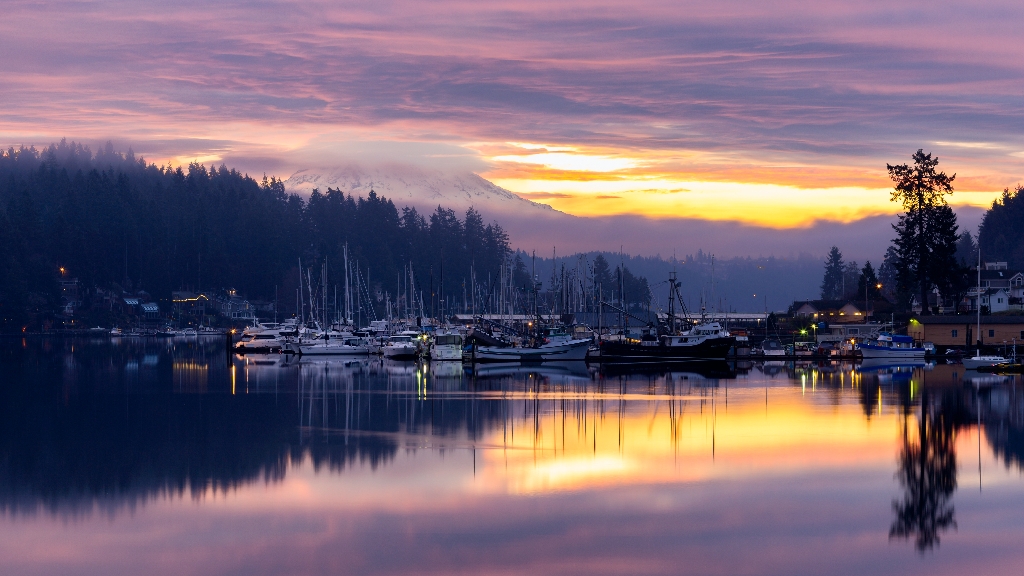
The Maritime Washington National Heritage Area (designated in 2019) encompasses 3,000 miles of western Washington’s saltwater coastline from Grays Harbor County to the Canadian border, 18 federally recognized tribes, 13 counties, 32 incorporated cities, and 30 port districts, as well as innumerable harbors, inlets, peninsulas, island shores, and parks—all connected by the nation’s largest ferry system. The Washington Trust for Historic Preservation, a state-wide non-profit dedicated to preserving the state’s historic resources, is the NHA’s Coordinating Entity.
Communities here were connected to the rest of the world by boat long before roads and railroads were built. The first peoples created complex cultures around canoe journeys and salmon cycles. Then came Spanish, English, Russian and American explorers in search of territory and shipping lanes. As the country developed, the region’s ports began to bolster trade of vast natural resources, and naval installations came to guard the continent.
Washington’s coastline is rich with historic buildings and vessels, museums, and archival collections, and the maritime industry remains a foundation of the region’s economy today. Shipyards, container ports, cruise ships, tugs, and marinas full of small and large pleasure craft are as much a part of this NHA’s inheritance as historic ships or lighthouses.
To read the Maritime Washington National Heritage Area management plan, click here.
The vast diversity of this living landscape can be divided by geographic regions:
Olympic Peninsula
The Olympic Peninsula is surrounded by the Pacific Ocean, the Strait of Juan de Fuca, and Puget Sound’s Hood Canal. The Olympic Mountains rise prominently in the interior. Historic ports, coastal communities, and traditional tribal lands rim this boxy landmass. Home to Olympic National Park, the peninsula features the longest stretch of publicly-owned and undeveloped shoreline on the Pacific Coast, and closely resembles the shoreline inhabited by the tribes before Europeans arrived. Olympic National Park is also a UNESCO World Heritage Site, designated for its ecosystem diversity, while the Olympic Coast National Marine Sanctuary lies offshore, distinguished for its educational opportunities.
Puget Sound
A complex inlet of the Pacific Ocean and the third-largest estuary in the United States, Puget Sound comprises many waterways, basins, and bays, including Seattle’s brackish Lake Union. For millennia, the sound connected the Northwest people to the sea – for travel, trade, sustenance, protection, and recreation. Today, Puget Sound is home to maritime industries, military bases, small coastal communities, the cities of Seattle, Tacoma, Everett, and the state capital Olympia. The Kitsap Peninsula and enchanting islands lie in the interior of Puget Sound, with the Hood Canal between them and the Olympic Peninsula.
Northern Coast
Along the western edge of Skagit and Whatcom Counties lies Washington’s northern coastline, a series of protected bays stretching north to the Strait of Georgia, which separates Vancouver Island from mainland Canada. The traditional aquaculture, fishing, and sea trade economies remain important in this region. Continuing a centuries-old tradition, northern coastal cities like Bellingham still provide jumping-off points for journeys to Alaska through the Inside Passage.
Salish Sea Islands
Three Northwest water bodies – the Strait of Juan de Fuca, Puget Sound, and Canada’s Strait of Georgia - are together called the Salish Sea. The over 400 islands that lie in these waters are the ancient homelands of native tribes and habitat for some of the region’s most diverse marine wildlife. This varied island environment– including Whidbey Island, one of the largest islands in the contiguous United States, and the San Juan archipelago— contains some of the most remote and rugged places in this region, as well as active ports and popular vacation destinations.
Is there something we missed for this itinerary?
Itineraries across USA


















































